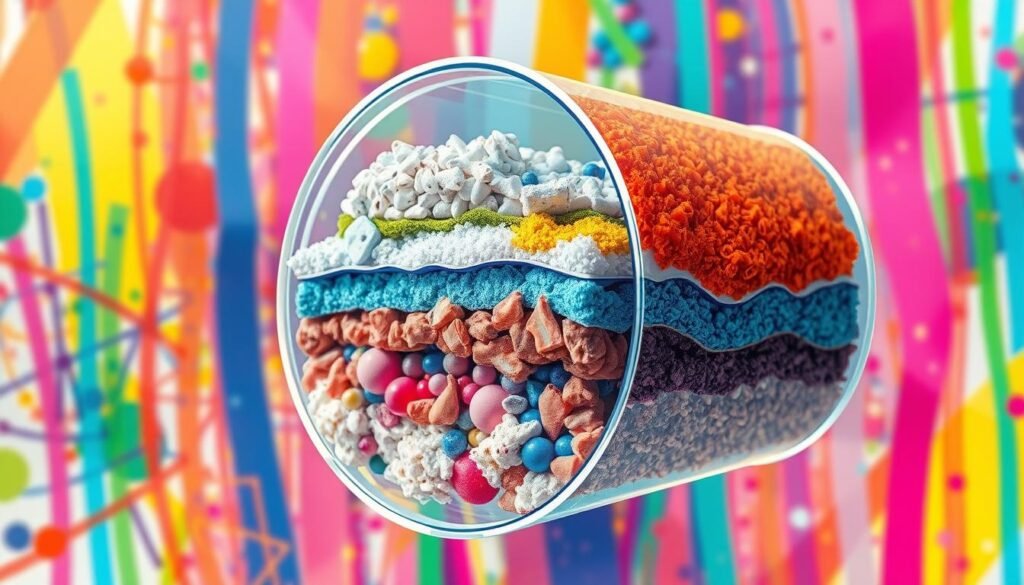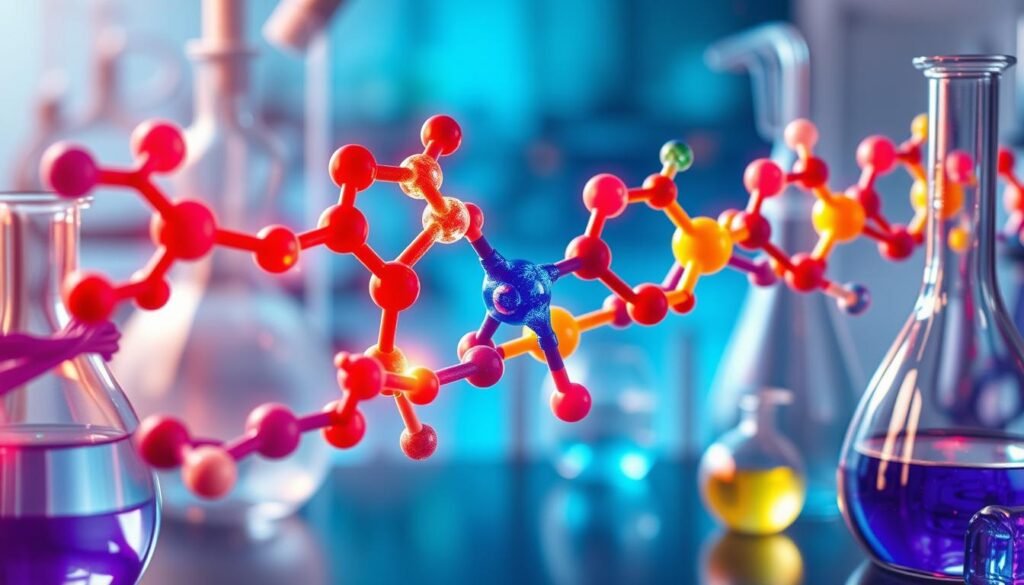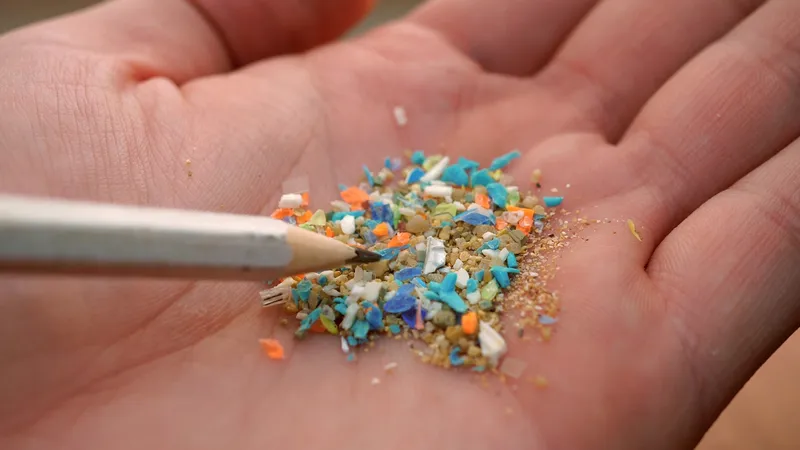Ever wondered about the mix of parts that make up plastics in our daily lives? We’re here to break down the polymer composition and show you the plastic ingredients that make different plastics. This article will help businesses understand plastic manufacturing better.

Exploring plastics is both fascinating and complex. It shows our commitment to top-notch recycling solutions. We aim to help our clients understand the science behind synthetic materials. This way, they can make informed decisions that matter.
Unveiling the Basics: Defining Plastic
Exploring the plastic industry starts with knowing what plastic is and how it works. This material has changed our world, becoming key in modern life.
Origin and General Characteristics of Plastics
Plastics are made from synthetic materials through a process called polymerization. They are known for being light, durable, and resistant to corrosion. These traits make plastics perfect for many uses, from cars to medical tools.

Types of Plastics: Thermosets vs. Thermoplastics
Plastics fall into two main groups: thermoset polymers and thermoplastic materials. Thermosets can’t be melted or reshaped once set, great for high-heat uses like car parts. Thermoplastics, on the other hand, can be melted and reshaped, making them useful for packaging and electronics.
| Properties | Thermoset Polymers | Thermoplastic Materials |
|---|---|---|
| Reusability | Non-recyclable | Recyclable |
| Heat Resistance | High | Variable |
| Typical Applications | Insulation, auto parts | Packaging, consumer products |
| Cost | Higher | Lower |
The Role of Polymers in Plastic Production
At the heart of plastic making are polymers, big molecules made of repeating parts. These molecules decide how plastics feel and work. Knowing about polymers helps us see new ways to make things in the plastic industry.
The Chemistry Behind Plastics
At the heart of polymer science, knowing the chemical properties of plastics is key. It helps in making recycling technologies better. This part looks at how simple chemicals turn into useful plastics for many industries.
Polymer chemistry is crucial for plastics to be more sustainable. It lets us make materials that perform well and can be recycled easily. By studying how plastics are made and their effects on the environment, we can improve recycling a lot.

- Molecular Structure: The way molecules are arranged in polymers affects their properties and uses.
- Reaction Mechanisms: Monomers combine to form polymers through polymerization. This process is influenced by catalysts and additives.
- Thermal Behavior: Knowing how plastics react to heat helps make materials that can handle extreme temperatures.
The effects of these chemical interactions are real and important. They impact how plastics are made and recycled. As we learn more about p>polymer chemistry, we find ways to make plastics less harmful to the environment.
| Feature | Impact on Recycling | Chemical Property |
|---|---|---|
| Molecular Weight | Higher molecular weights can complicate processing and recycling. | Determines strength and resistance |
| Thermal Stability | Materials with higher thermal stability are more recyclable. | Ability to resist degradation at high temperatures |
| Polymerization Type | The type of polymerization affects the recyclability of plastics. | Linked to the method of polymer connection |
Through research and development in p>polymer science, we aim to make the plastics industry more sustainable. Every step forward in understanding and improving p>chemical properties of plastics makes products better and helps the environment.
The Building Blocks: Monomers and Polymers
We explore the essential parts of plastic, focusing on monomers and polymers. These elements are key in making modern plastics. Our knowledge in polymer science helps us improve recycling methods.
Understanding Monomers: The Foundation of Plastic
Monomers are the basic parts of all plastics. They are tiny molecules that link up to form polymers. The type and how they connect affect the plastic’s strength and durability.
How Polymers Form and Determine Plastic Properties
The change from monomer to polymer is crucial in polymer science. This change gives plastics their special traits. By controlling this process, we can make polymers with the right mix of flexibility, strength, and durability.
Diving into Polymerization: The Creation Process
The polymerization process has two main types: addition and condensation. Each type affects the polymer’s strength and durability. We focus on making sure recycled polymers are of high quality and durable.
| Monomer Examples | Polymerization Type | Plastic Property Influenced |
|---|---|---|
| Ethylene | Addition | Film flexibility |
| Caprolactam | Condensation | Fiber toughness |
| Styrene | Addition | Impact resistance |
| ethylene glycol and terephthalic acid | Condensation | Bottle durability |
We are dedicated to leading in recycling technology for polymers. Our deep knowledge of polymerization helps us improve recycling. This way, we not only reuse materials but also make them better for longer use in many industries.
From Raw Materials to Everyday Products
In today’s world, turning raw materials into useful items is key. Plastic is a big part of this, thanks to its flexibility and lasting quality. We look at how plastics go from raw materials to everyday items. This includes bioplastics and traditional plastics.
The Journey from Petroleum to Plastic
Most plastics start from oil. This shows how important oil is in making things. By refining and changing oil, we get plastics that are all around us. Making these plastics better for the planet is a big goal.
Plastics in the Manufacturing Industry
Plastic is a top choice in making things. It’s used for car parts and food packaging because it’s light and strong. We’re working to make plastic production better and greener.
Bioplastics: Harnessing Nature for Plastic Production
Bioplastics are a new and exciting area. They come from plants like corn and algae. They’re good for the planet and help us use less oil.
| Material Type | Source | Biodegradability | Uses in Industry |
|---|---|---|---|
| PET (Polyethylene Terephthalate) | Petroleum | No | Packaging, Bottles |
| PLA (Polylactic Acid) | Corn Starch | Yes | Food Packaging, Disposable Tableware |
| PHA (Polyhydroxyalkanoates) | Microbial Biosynthesis | Yes | Medical Devices, Packaging |
This table shows the variety of plastics and bioplastics we use. We’re working to improve our methods. Our goal is to meet industry needs while protecting the environment.
Conclusion
We’ve explored plastics deeply, from its chemical makeup to its role in our lives. We’ve seen how plastics are made and how they impact our world. Now, we focus on making plastics better for our planet.
As we move forward, we aim to make plastics more eco-friendly. We want to reduce plastic’s harm on our environment. Our goal is to improve recycling and shape a better future for plastics.
We’re committed to creating top-notch recycling machines. These machines help businesses and experts work more efficiently and protect the environment. They fit seamlessly into your operations, supporting recycling and sustainable practices.
We’re on the brink of a big change, thanks to new technology and a shared dream for a green future. We guide our clients towards a future where plastics are made and recycled wisely. Together, we’re building a future where industry and nature go hand in hand.
FAQ
What are the primary components that make up plastic materials?
Plastics are made mainly of polymers, which are long chains of repeating units called monomers. Additives like stabilizers and colorants are also added. These help improve the plastic’s properties.
Can you explain the difference between thermoset and thermoplastic materials?
Thermoset plastics can’t be melted and reshaped once they harden. On the other hand, thermoplastics can be melted and reshaped many times. This makes thermoplastics recyclable.
What role do polymers play in the production of plastic?
Polymers are the backbone of plastics, defining their strength and flexibility. They also determine how well the plastic withstands environmental factors.
How do monomers relate to polymers in plastic chemistry?
Monomers are the building blocks of polymers. They bond together to form long chains, creating different types of plastics.
How does the polymerization process affect the properties of the final plastic product?
The way polymers are formed through polymerization affects their structure. This structure impacts the plastic’s durability and how well it handles heat.
How are sustainable practices incorporated into the manufacturing of plastics?
The plastic industry uses bioplastics made from plants and improves recycling. It also works to use raw materials more efficiently to cut down on waste and energy use.
What technological advancements are being made in the plastic recycling industry?
New technologies in recycling include better sorting machines and chemical recycling. These methods break down plastics into their original components. There’s also a focus on biodegradable plastics.
How does your company contribute to responsible plastic manufacturing and recycling?
We design recycling machines that make plastic reuse more efficient. Our goal is to support responsible plastic use and reduce its environmental impact through innovation.
